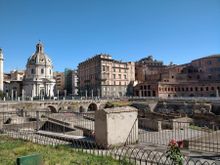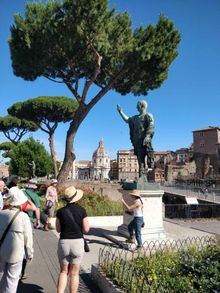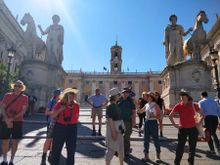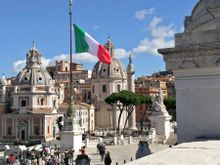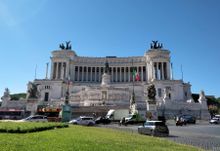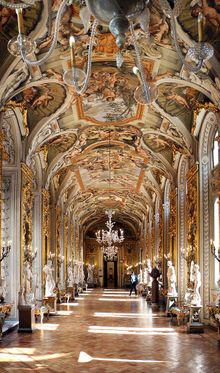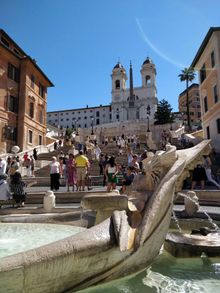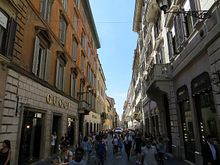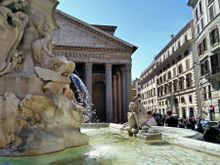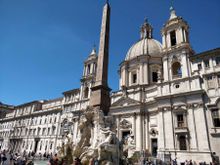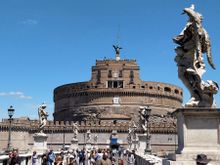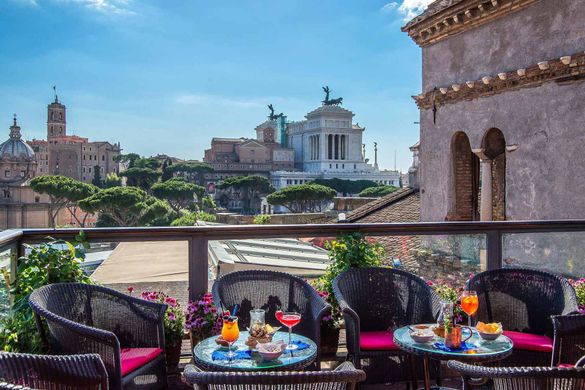 30 Sep 2018
30 Sep 2018
Tags: Rome, Best places in Rome, One day in Rome, Walking Tour of Rome, Caspin Journeys, walking tours, luxury travel, High End travels, cultural holidays, Quality tourism in Italy, Italy, Discover Italy, Local Guides, family run tour operator, Bespoke, tailor-made tours

Discover the real soul of Rome
We don't usually visit the major cities with our tours: they are too crowded and most of the time our guests want to go around at their own pace. With our new tour on the Via Francigena we stopped in Turin, Piacenza, Lucca, Viterbo and Rome. We are now happy to share our experience with you.
Condense almost 3000 years of history of the beautiful Rome in a simple blog post is a kind of heresy! So we thought to give you a little guide for your next visit to the Italian capital to make the best out of your time and to not miss the very best spots of this incredible ancient city.
We wrote some descriptions and curiosity for each stop. Follow the map bellow or make your own way through the narrow streets of Rome City Centre because
“Sometimes it takes a wrong turn to get you to the right place.” cit.
You need to walk the streets of Rome to really understand it. At your own pace, obviously.
So now let's start with the journey!
From the Imperial Fora to Castel Sant'Angelo
1 – I FORI IMPERIALI

The Imperial Fora – I Fori Imperiali in Italian – are series of monumental fora (public squares), constructed in Rome over a period of one and a half centuries, between 46 BC and 113 AD. The forums were the centre of the Roman Republic and of the Roman Empire.
Julius Caesar was the first to build in this section of Rome. These forums were the centres of politics, religion and economy in the ancient Roman Empire.
During the early 20th century, Mussolini restored the Imperial Fora as part of his campaign to evoke and emulate the past glories of Ancient Rome. He also built the Via dei Fori Imperiali across the middle of the site, supposedly in order that he could see the Colosseum from his office window but mainly to give a unique and suggestive view on the archeological area. He also commissioned all the bronze statues that we can admire today walking on the Via dei Fori Imperiali: his idea was to help the visitors identifying the different fora and connect them with their emperors.
 2 – PIAZZA DEL CAMPIDOGLIO
2 – PIAZZA DEL CAMPIDOGLIO
Campidoglio Square is situated on the Capitoline Hill which is always been privileged seat of divinity and power, although it is the lowest and least extensive of the Seven Hills of Rome – Aventino, Campidoglio, Celio, Esquilino, Palatino, Quirinale, Viminale). In the early VI century BC on the Capitoline Hill stood the Temple of Jupiter Optimus Maximums Capitolinus, by far the most important temple of Ancient Rome.
Near the present-day church of Santa Maria in Are Coeliacs was instead the Temple of Juno Moneta. It was precisely in this Temple that the first mint of Rome was established, and the goodness's epithet later gave rise to the Italian word “moneta”, to mean “coin”.
The square, as actual city element, was created only starting in VI century when Pope Paul III entrusted its arrangement to Michelangelo Bonarroti. The artist designed the star-shaped pavement pattern, the façade of Palazzo Senatorio – seat of the City of Rome since 1143 – and the two palaces embracing the square, today the well known Musei Capitolini, the oldest museums in the world.
The equestrian statue of Marcus Aurelius – the Emperor of maximum expansion of Imperial Rome – managed to pass un harmed through the Middle Ages, a period when all metals sculptures and architectural elements where melted and reused. This was only thanks to a misunderstanding: the popes, who were its owners until the 15th century, thought that it was the statue of Costantine, the fist Christian emperor. What we see today in the square is only a copy while the original is inside the adjacent Musei Capitolini.

3 – IL VITTORIANO

Inaugurated in 1911, it is a monument devoted to the first king of the new unified Italy Vittorio Emanuele II di Savoia (official date for unification of Italy is 1861).
The Vittoriano holds the Tomb of the Unknown Soldier with an eternal flame, built under the statue of goddess Roma. This Unknown Soldier symbolises all the Italian soldiers dead during the First World War. The body of the Unknown Soldier was chosen from among 11 unknown remains by a woman whose only child was killed during World War I. Her son's body was never recovered. This ceremony happened with a state funeral on 4 November 1921.
The Vittoriano is the largest monument in Rome but it has been always controversial since its construction destroyed a large area of the Capitoline Hill with Medieval and Renaissance neighbourhood – here it was where Michelangelo lived until his death.

Also the material, corpse-white marble imported from Brescia – Lombardy in northern Italy – makes the Vittoriano a fish out of water between the brownish buildings surrounding it. Anyway the Romans had – and have still – to deal with it so they gave it a number of interesting nicknames like “torta nunziale” wedding cake, “dentiera” dentures, “macchina da scrivere” typewriter, and so on.
4 – PIAZZA VENEZIA
At the foot of the Capitoline Hill opens out Piazza Venezia, which takes its name from the monumental palace ordered by Pope Paul II, who was of Venetian origin, in the mid-XV century.
Another remarkable build is Bonaparte Palace where Maria Letizia Bonaparte, Napoleon's mother, lived until his death. She used to seat on the balcony to watch the hectic life of the capital passing by and when she became blind it was her chaperon to tell her what was going on down on the streets.
5 – PALAZZO DORIA PAMPHILJ
The presence of the papacy in Rome has undoubtedly influenced the city's history, affecting its urbanist and monumental development as well. The patronage of popes and cardinals, supported by enormous financial resources coming also from heavy taxes imposed on the Roman citizens, left numerous examples of the luxury with which the nobles family loved to surround themselves.

Palazzo Doria Pamphilj, home of one of the most prestigious art collections in the world with works from Caravaggio, Raffaello, Tiziano, Bernini, etc., is still owned by the noble family who lives in a private section of the palace.
The history of the building, which in the XVI century was owned by the Adobrandini family, is directly connected with the vicissitudes of the family. Giovanni Battista Pamphilj, pope from 1664 with the name of Innocenzo X, built for himself and his family a beautiful building in Piazza Navona which we will see later on on the tour. Following the tradition, his nephew Camillo was appointed cardinal, or rather as it was said at the time “master cardinal”, because he combined under his control so many different offices. In practice he controlled all the Church State. He felt in love with Olympia Aldobrandini, whom he married after abandoning the purple. This caused great indignation between both families, Aldobrandini and Pamphilj. The young couple got married in secret outside of Rome and there they stayed until things cooled down. After that they decided to come back to Rome and to come live in the Palazzo Adobrandini, actual Palazzo Doria Panphilj, which was enlarged and made more beautiful, also because it had to contain the magnificent art collection that can still be admired today.
Curiosity: the Palace aroused the amazement and embarrassment of Kaiser Wilhem II of Germay who, participating to a reception here in 1882, felt the need to excuse himself for not being able to return such hospitality.
Palazzo Doria Panphilj Gallery is open everyday from 9.00 am to 7.00 pm. (last admition at 6.00 pm). Ticket € 12. They accept credit card payment. Visit their website >
6 – FONTANA DI TREVI 1642
Undoubtedly there is no city in the world which that has more water and fountains than Rome. It has been thus since ancient time, when 11 aqueducts supplied thousand and thousands of litres of water a day to the city, feeding the counties fountains and magnificent baths other than its citizens' needs.
The sacking of the Goths, resulting in the cutting of the aqueducts, ended this richness, and only until the end of the XVI century did the popes tackle the water supply issue adequately. Since then Rome was adorned by dozen of monumental fountain celebrating the city and papal magnificent. And still today, while we admire these masterpiece, we can refresh ourselves by drinking the excellent water running from the small street fountains called by the locals “nasoni”, big noses, because of the curious shape of the curved pipe.

Fontana di Trevi, a masterpiece by Nicola Salvi who created it in between 1732 and 1762, is certainly the most famous fountain of Rome, made even more famous by Federico Fellini's movie “La Dolce Vita”. The fountain is the terminal part of the Vergine aqueduct built by Agrippa, a general of Augustus, in 19 BC to bring water coming from the Salone springs, 19 km away, to Rome.
Legend, illustrated in the fountain's upper panels, wants that was a young girl who showed Agrippa's thirsty soldiers where the abundant spring was. This aqueduct is the only one in Rome that has remained in use almost uninterruptedly from the time of its construction to the present days!! This is the aqueduct that supplies water to the major fountains of the city centre, from Piazza di Spagna to Piazza Navona.
The name Trevi derives from the Latin word “trivium”, the meeting point of three streets.
And of course everyone know that, if you want to return to Rome, you have to throw a coin into the basin. But for the dream to come true you have to do it with your back to the fountain!
7 – PIAZZA DI SPAGNA

Another well known spot in Rome, Piazza di Spagna takes his name from the Spanish Embassy which has its building in the square.
Piazza di Spagna is extremely original in shape, with a narrowing at the centre which divides the square into two parts, like a butterfly's wings. Since XVII century it has been the meeting point for travellers coming from all around the world, who could easily arrive here with carriages. Thus hotel, shops and cafes began to spring up, where painters, writers and children of rich families would meet, in an international atmosphere.
At the foot of the staircase of church Trinita Dei Monti, the famous Spanish Steps, there is Fontana della Barcaccia, work of Pietro Bernini who created it in around 1629, probably with the aid of his famous son Gian Lorenzo Bernini.
According to the legend, the interesting shape of the fountain was commissioned by Pope Urban VIII to Barberini to commemorate a boat that had ended up in the square after the great flood of 1598. In reality, it was more a necessity than a symbol because here the water pressure of the Vergine aqueduct is rather low, and it was necessary to create a fountain beneath the ground level.
8 – VIA CONDOTTI

From Piazza di Spagna branch off the most well-known and elegant street in Rome, such as Via Condotti, “twinned” with London's Bond Street, today perhaps one of the city's most loveliest pedestrian area. Popular in the past with celebrities such as King Juan Carlos of Spain, Jackie Kennedy Onassis, John Wayne, Nelson Rockfeller, Ingrid Bergman, Audrey Hepburn and many many others, it is still a favourite shopping haven for all famous and important visitors passing through Rome.
Originally Via Trinitatis, traced out in 1544 during the papacy of Paul III to connect the church of Trinità dei Monti to the Tiber, Via Condotti owes its present-day name to Pope Gregory XIII who, in the late XVI century, had the conduits of the Vergine aqueduct, the one that supplies water to the Trevi Fountain, pass underground here.
The major designer names you can find along Via Condotti are numerous and some of the most prestigious such as Armani, Prada, Gucci, Valentino, Bulgari, Alberta Ferretti, Ferragamo, Cartier, Hermes, Max Mara and Iceberg.
No food or beverage shops on this street, except for the renowned Antico Caffè Greco, a famous resort of Italian and foreign artists and literati present in 19th-century Rome. Founded in 1760 by Nicola della Maddalena, a Greek, the café achieved fame later when it began to serve better coffee, served in small cups. Much appreciated by foreigners was also the service, which made it possible to receive mail in a characteristic wooden box situated near the entrance. Among the most famous habitúes of the café were Liszt, Gounod, Stendhal, Heine, Wagner, Schopenauer, Twain, Gogol, Trilussa and D'Annunzio.
The café has maintained its 19th-century appearance still today, making it a necessary coffee stop during your 1 Day Walking Tour of Rome. Just an advice for your pockets: have a look around the charming café but remember to enjoy your fresh coffee at the bar!!
9 – MONTECITORIO

The palace's name derives from the hill on which it is built, which was claimed to be the Mons Citatorius.
The building was originally designed by Gian Lorenzo Bernini but then the work was completed by architect Fontana.
With the Unification of Italy in 1861 and the transfer of the capital to Rome in 1870, Montecitorio was seized by the Italian government and chosen as the seat of the Chamber of Deputies.
10 – PANTHEON
Your 1 Day Walking Tour of Rome leads you to the unexpected Piazza della Rotonda which takes its name from the unmistakable structure of the Pantheon.

Pantheon is the building of Ancient Rome which has been preserved best down to the present day. It is true masterpiece of architecture.
The entire building is result of a well calculated balanced. It is a sphere inserted in a cylinder.
Agrippa, name that can still be read now on the façade, was the son-in-law of Augustus, who first built this temple to be dedicated “to all the gods” of Ancient pagan Rome. The present-day Pantheon, however, completely different from the original, is the work of the Emperor Hadrian, who rebuilt the monument in the early II century, keeping only the ancient inscription out of modesty.
The most amazing characteristic of the building is the exceptional dome. The largest dome ever created out of unreinforced concrete!!! It measures 43.3 mt in diameter and is greater than that of the dome of St. Peter's. It is increasingly lighter as we go upwards, ending with an open circular window, the “eye”, with a diameter of 9 mt. Through this opening enters the rain, which is conveyed into the drains visible on the pavements.
Today Pantheon is the sanctuary of the kings of Italy: it holds the tombs of Vittorio Emanuele II, Umberto I and Margherita di Savoia – the queen of the Pizza Margherita! But that's another story ????
11 – PIAZZA NAVONA
One of the most popular pizzas in Rome, Piazza Navona is important for events and markets, especially during Christmas and Epiphany time.
The original shape of the piazza repeats the perimeter of the ancient stadium of Domitian built in 86 A.D. for athletic competition. The actual shape and size of Piazza Navona were impressed in XVII century since the Pamphilj family moved their headquarter in this area and commissioned to the best architects and artist of the time to turn it into one of the most scenic and beautiful space of the city.

In the centre of the square rises the famous Fountain of the Four Rivers, designed again by Gian Lorenzo Bernini to support the magnificent obelisk. The monolith of red granite, executed in the I century A.D. in imitation of the Egyptian ones to celebrate the Emperor Domitian, was perhaps intended for the Temple of Isis in the Campus Martius. Apparently it remained for a long time broken into five pieces inside a circus on the Appian Way where Emperor Maxentius decided to put it. In 1649 it was found and arranged by pope Innocent X Pamphilj in its present position, in the centre of the fountain. Immediately afterwards the bronze point was placed on top, decorated on its tip with a dove carrying an olive branch, which belonged to the coat of arms of the Pamphilj family: in this way a strong symbolic connotation was given to the complex, because the papal dove dominates and transmits the Truth of the Gospel to the four continents, depicted allegorically by the four rivers at the base. The Danube, the Ganges, the Rio de la Plata and the Nile are represented as river-gods, easily recognisable by their individual attributes. The Nile, in particular has its face covered with a veil: this is not because, as suggested by the malicious, it does not want to look at the church of St Agnese, but to show the mystery that still surrounded the origins of the river's sources.
The church of St Agnese in Agone (agones meaning games) stands where the 12-years-old Agnese was martyred at the end of the III century during the persecutions of the emperor Diocletian. Legend wants her nakedness covered by the miraculous growth of her hair.
One of the most interesting facts about piazza Navona is the so called “lake”. During the hottest mouth of the year the piazza used to be floated to give a nice refresh mainly to the Pamphilj family members that used to live here but also to the Roman citizen. The custom was interrupt in the late 1800s for sanitary reasons.
12 – CASTEL SANT'ANGELO
Castel Sant'Angelo was built in the early II century A.D. by Emperor Hadrian as a mausoleum, a monumental tomb for himself and his successors. It was highly decorated with rich metals and pieces of art. With the Visigoths and Goths attacks to the city most of them disappeared or they have been destroyed.

Ponte San'Angelo, Sant'Angelo Bridge, is decorated with marble statues of angels as symbols of the Passion of Christ designed by Gian Lorenzo Bernini.
It was only from the XIII century that the popes annexed Castel Sant'Angelo to the Vatican to be used ad a fortress and a prison. Giordano Bruno was imprisoned here for six years.
The name Sant'Angelo with which the fortress is known derives from a miraculous event which took place in 590 A.D.: Rome was in the midst of a severe plague, and Pope Gregory the Great had organised a solemn procession to pray for its end. When the procession reached the Mole of Hadrian, Archangel Michael was seen flying up and sheathing his flaming sword, symbolising the end of the plague. The statue of the angel, placed on the top of the castle to commemorate the event, was replaced six times.
From Castel Sant'Angelo you are not far from the Vatican with its breathtaking churces and pieces of art.
Take your time to have rest before your tour at the Vatican Museums starts. We advise to have lunch in a traditional beautiful restaurant just 20min far from the Museums: Restaurant "da Romolo alla Mole Adriana" in Vicolo del Campanile 12. Fresh food and traditional recipes for the perfect lunch break!
Happy travel from the Caspin Family!!!
ENDS


